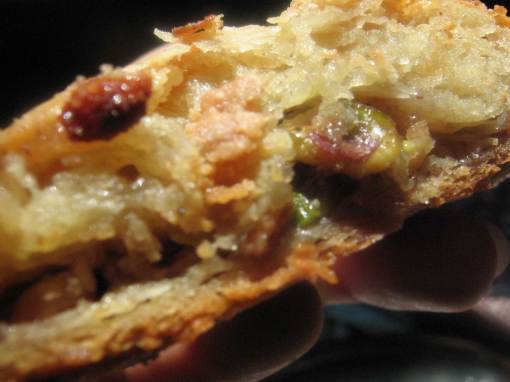This month the Daring Bakers made a Caramel Cake with Caramelized Butter Frosting courtesy of Shuna Fish Lydon, as published on Bay Area Bites. Dolores of culinary curiosity and Alex (Brownie of the Blondie and Brownie duo), Jenny of Foray into Food were our hosts.
I made my cake on the Wednesday before Thanksgiving for a little pre-holiday potluck and it turned out pretty well, perfectly serviceable, but not amazing. I would probably revisit my adaptations before making it again – the texture was just a little too funky. Still, I did love the caramel flavors, so I might come back to this challenge and rework it.
Sadly, when I left the party, I discovered that my car had been broken into. Nothing was taken, but the passenger side window was smashed, which means that I’m out $200. With the hub-bub of Thanksgiving, and trying to get the glass replaced, the cake and this post were completely forgotten. It is still hanging out in the brown paper bag which I never unpacked, and is probably as stale as a rock… and I am a day late in getting this out.
CARAMEL CAKE WITH CARAMELIZED BUTTER FROSTING
10 Tablespoons unsalted butter at room temperature
1 1/4 Cups granulated sugar
1/2 teaspoon kosher salt
1/3 Cup Caramel Syrup (see recipe below)
2 eggs, at room temperature
splash vanilla extract
1 cup tapioca starch
1/2 cup sorghum flour
1/2 cup rice flour
1 1/2 teaspoons xanthan gum
1 teaspoon baking powder
1 cup milk, at room temperature
Preheat oven to 350F
Butter one tall (2 – 2.5 inch deep) 9-inch cake pan.
In the bowl of a stand mixer fitted with a paddle attachment, cream butter until smooth. Add sugar and salt & cream until light and fluffy.
Slowly pour room temperature caramel syrup into bowl. Scrape down bowl and increase speed. Add eggs/vanilla extract a little at a time, mixing well after each addition. Scrape down bowl again, beat mixture until light and uniform.
Sift flour and baking powder.
Turn mixer to lowest speed, and add one third of the dry ingredients. When incorporated, add half of the milk, a little at a time. Add another third of the dry ingredients, then the other half of the milk and finish with the dry ingredients. {This is called the dry, wet, dry, wet, dry method in cake making. It is often employed when there is a high proportion of liquid in the batter.}
Take off mixer and by hand, use a spatula to do a few last folds, making sure batter is uniform. Turn batter into prepared cake pan.
Place cake pan on cookie sheet or 1/2 sheet pan. Set first timer for 30 minutes, rotate pan and set timer for another 15-20 minutes. Your own oven will set the pace. Bake until sides pull away from the pan and skewer inserted in middle comes out clean. Cool cake completely before icing it.
Cake will keep for three days outside of the refrigerator.
CARAMEL SYRUP
2 cups sugar
1/2 cup water
1 cup water (for “stopping” the caramelization process)
In a small stainless steel saucepan, with tall sides, mix water and sugar until mixture feels like wet sand. Brush down any stray sugar crystals with wet pastry brush. Turn on heat to highest flame. Cook until smoking slightly: dark amber.
When color is achieved, very carefully pour in one cup of water. Caramel will jump and sputter about! It is very dangerous, so have long sleeves on and be prepared to step back.
Whisk over medium heat until it has reduced slightly and feels sticky between two fingers. {Obviously wait for it to cool on a spoon before touching it.}
Note: For safety reasons, have ready a bowl of ice water to plunge your hands into if any caramel should land on your skin.
CARAMELIZED BUTTER FROSTING
12 tablespoons unsalted butter
1 pound confectioner’s sugar, sifted
4-6 tablespoons heavy cream
2 teaspoons vanilla extract
2-4 tablespoons caramel syrup
Kosher or sea salt to taste
Cook butter until brown. Pour through a fine meshed sieve into a heatproof bowl, set aside to cool.
Pour cooled brown butter into mixer bowl.
In a stand mixer fitted with a paddle or whisk attachment, add confectioner’s sugar a little at a time. When mixture looks too chunky to take any more, add a bit of cream and or caramel syrup. Repeat until mixture looks smooth and all confectioner’s sugar has been incorporated. Add salt to taste.
Note: Caramelized butter frosting will keep in fridge for up to a month.
To smooth out from cold, microwave a bit, then mix with paddle attachment until smooth and light









